Design of Eco-Efficient Body Parts for Electric Vehicles Considering Life Cycle Environmental Information
Abstract
:1. Introduction
2. Background
3. Literature Review
- Firstly, body parts have to be designed for different materials and manufacturing concepts with regard to the fulfillment of mechanical properties. With respect to the early conceptual design phase, the method input should rely on simplified product models. Typically, no CAD (Computer Aided Design) or FE (Finite Element) models exist as a basis to generate design options that incorporate new materials or change the design of components. At the same time, available installation space should be considered as a boundary condition, as packaging is a major challenge in vehicle development. In order to qualify a broad solution, methods should enable a comparison of different material alternatives.
- Secondly, life cycle environmental impacts need to be determined for the derived conceptual designs. In line with conceptual design, method inputs should rely on descriptions of the component life cycle regarding its fore- and background system. Based on those inputs, different scenarios and associated variabilities within the vehicle life cycle need to be determined. This includes technological, temporal and spatial variabilities. For this reason, a model-based approach that enables to vary key parameters needs to be followed.
- Thirdly, an interpretation and prioritization of concept alternatives should be enabled. This implies that quantified results can be derived from both models and integrated in a joint interpretation of both. The interpretation should be tailored for engineering designers and related decision-makers as the major target audience.
4. Design of Eco-Efficient Body Parts Considering Life Cycle Environmental Information
4.1. Design Method
4.2. Environmental Assessment
4.3. Part- and Vehicle-Specific Influencing Factors
4.4. Interpretation and Visualization of Results
5. Verification of the Concept by Means of a Case Study
5.1. Joint Interpretation and Visualization of Part—And Vehicle-Specific Influence Fators
- For outer and inner panels, Al1 and GFRP 1 concepts are in most cases advantageous compared to reference steel designs. Only vehicle part concepts that are operated in an ownership mobility concept, an electricity mix with low emissions and a low manufacturing yield are expected to lead to higher life cycle impacts than the reference. The GFRP 1 concept is slightly advantageous to the Al1 concept.
- For structural parts, which are designed on tension/compression or bending stiffness, only CFRP 2 concepts are competitive against reference steel concepts. The higher the impacts of the electricity mix per kWh and the manufacturing yield and considering an MaaS operation, the more likely it is that the CFRP 2 concepts are advantageous. For bending load cases, this condition is more relevant than for tension/compression load cases.
- For structural parts, which are designed on torsional stiffness, aluminum and GFRP concepts are in most cases advantageous compared to steel concepts, with GFRP 3 concepts being most advantageous. Only within an ownership mobility concept and a use stage, an electricity mix with low emissions, while simultaneously expecting a low degree of manufacturing yield, these concepts are not advantageous.
5.2. Interactive Visualization as Part of The Design Process
6. Conclusions and Outlook
6.1. Conclusions
6.2. Outlook
- The proposed design method targets single part replacements based on simplified geometries. While providing good insights for a range of applications in automotive industry, further refinement will be performed. This especially targets automated generations of conceptual designs of multiple parts at a time within a given installation space. While the proposed approach allows an extension towards addressing those issues, a major challenge lies in the design of algorithms to handle computational complexity.
- The LCA-based evaluation methodology applies simplifications in relating product and process parameters with resulting environmental impacts. For example, future efficiency gains or market effects have not been considered and only average values for the GHG emissions of electricity supply are analyzed. A higher resolution of the markets is desirable. In addition, future GHG emissions for electricity supply decrease due to the application of renewable energy sources. Therefore, it is to be expected that the emission intensive production of e.g., FRP decrease. Omitting those effects limits the accuracy of the obtained results, especially in the case of materials with an emission intensive production. As well, the characterization of mobility concepts should be refined as assumed energy reduction values and lifetime mileages represent assumptions at the current stage. Furthermore, the sole evaluation of GHG emissions is not sufficient for complex technical systems. This also includes the introduction of constraints with relation to global sustainability goals.
- The derived models and engineering charts can and will be applied to a number of further design processes within automotive manufacturing. More detailed feedback from engineering designers and project managers is expected to obtain further requirements on evaluation methods as well as the representation of results in engineering charts or tools. This could lead to the introduction of further design parameters or omission of others. As well, benefits and obstacles of static engineering charts to interactive representations will be elaborated for the specific case. While the first provides direct decision support based on a predefined scenario, interactive charts could lead users to form and test own hypotheses.
Author Contributions
Funding
Conflicts of Interest
Appendix A
| Semi-Finished Product | Index | Material Properties | |||
|---|---|---|---|---|---|
| Ex 1.) | Ex 2.) | G | ρ | ||
| [N/mm2] | [N/mm2] | [N/mm2] | [kg/m3] | ||
| DC04 | St | 210,000 | 210,000 | 79,300 | 7850 |
| TL091 T6 | Al | 70,000 | 70,000 | 25,500 | 2700 |
| GFRP (φ = 0,42; EP; quasi-isotropic) | GFRP 1 | 18,200 | 18,200 | 3300 | 1700 |
| GFRP (φ = 0,5; EP; [±45°/0°/0°/0°/0°]S) | GFRP 2 | 33,200 | 25,800 | 5400 | 1820 |
| GFRP (φ = 0,5; EP; [0°/±45°/±45°/±45°/±45°]S) | GFRP 3 | 17,700 | 25,200 | 9400 | 1820 |
| CFRP (φ = 0,42; EP; quasi-isotropic) | CFRP 1 | 46,600 | 46,600 | 3200 | 1450 |
| CFRP (φ = 0,5; EP; [±45°/0°/0°/0°/0°]S) | CFRP 2 | 97,000 | 67,300 | 9100 | 1500 |
| CFRP (φ = 0,5; EP; [0°/±45°/±45°/±45°/±45°]S) | CFRP 3 | 34,700 | 64,800 | 24,900 | 1500 |
| Semi-Finished Product | Description | Region | Material Composition | Life Cycle Inventory Dataset(s) Used as a Basis | Source |
|---|---|---|---|---|---|
| DC04 | Steel sheet | Germany | C 0,08% P 0,030% S 0,030% Mn 0,4% | 569eb248-58e3-4c3b-87dc-28370e15bd77 | http://www.gabi-software.com/support/gabi/gabi-database-2019-lci-documentation/ |
| TL 091 T6 | Aluminum sheet | Germany | Si 0,40–0,80% Fe 0,70% Cu 0,15–0,40% Mn 0,15% Mg 0,80–1,2% Cr 0,04–0,35% Zn 0,25% Ti 0,15% | dfd81ac6-600b-4867-b59a-c27aa33c5763 | |
| GFRP | Glass Fiber | Germany | fiber-mass-ratios: 0,42 & 0,5 | ee377281-8d03-4dbe-90bf-fa51f61556a2 | |
| CFRP | Carbon Fiber | Germany | d2e4cb14-c5fa-49a3-b6c2-840a2b860d63 | ||
| GFRP, CFRP | Epoxy resin | Germany | 50125a08-978e-4156-bcc0-2d13ec3b49c7 |
| Manufacturing Process | Applied for Semi-Finished Products | Life Cycle Inventory Dataset(s) Used as a Basis | Source |
|---|---|---|---|
| Deep drawing | DC04 | 1c32edbb-3602-4a7a-81cd-244f82ebb3b6 | http://www.gabi-software.com/support/gabi/gabi-database-2019-lci-documentation/ |
| Deep drawing | TL 091 T6 | ac011c4e-ef9a-49ee-9302-2f8e1ecf4c05.xml | |
| Resin Transfer Molding (RTM) | GFRP, CFRP | 12,8 MJ/kg | [40] |
| Pultrusion | GFRP, CFRP | 3,1 MJ/kg | [40] |
| Assumptions for the Assessment of the Use Stage | |||||
|---|---|---|---|---|---|
| Nr. | Parameter | Value | Unit | Source | |
| 1 | Powertrain efficiency | ηTrac. | 85,0 | % | [27] |
| 2 | Recuperation efficiency | ηRegen. | 80,0 | % | [21] |
| 3 | Battery charge efficiency | ηChar. | 90,0 | % | [27] |
| 4 | Rolling resistence coefficient | cr | 0,7 | % | [27] |
| 5 | Energy reduction value | eERV | 3,0E-05 | kWh/km*kg | Own calculation |
| Process | Life Cycle Inventory Dataset(s) Used as a Basis | Source |
|---|---|---|
| Car shredder | 9913bb52-74bc-47ae-b794-d80ee214705c | http://www.gabi-software.com/support/gabi/gabi-database-2019-lci-documentation/professional-database-2019/ |


Symbols
| A | mm2 | Area of the cross section |
| a | - | Normalized area of the cross section |
| b | mm | Breadth |
| E | MPa | E-modulus |
| eDMat. | kg CO2-eq./kgMat. | Specific environmental credit related to material recovery |
| eElec. | kg CO2-eq./kgMat. | Specific environmental impact related to electricity production |
| eEMat. | kg CO2-eq./kgMat. | Specific environmental impact related to recycling |
| eEoL | kg CO2-eq./kgMat. | Specific environmental impact in End-of-Life |
| eERV | kWh/100 km * 100 kg | Specific energy reduction value |
| eLC | kg CO2-eq./kgMat. | Specific environmental impact |
| eMat. | kg CO2-eq./kgMat. | Specific environmental impact in upstream chain |
| eProd. | kg CO2-eq./kgMat. | Specific environmental impact in manufacturing stage |
| ePres. | kg CO2-eq./kgMat. | Specific environmental impact related to production process |
| eRMat. | kg CO2-eq./kgMat. | Specific environmental impact related to material production |
| eSMat. | kg CO2-eq./kgMat. | Specific environmental credit related to material recovery |
| eUse | kg CO2-eq./kgMat. | Specific environmental impact in use stage |
| h | mm | Height |
| Iy | mm4 | Moment of inertia |
| iy | - | Normalized moment of inertia |
| K(x) | mm4 | Shape function of the bending line |
| l | mm | Length |
| M | kg/(mm2 * N)0,5 | Mass index |
| M2/M1 | - | Potential of lightweight design |
| m | kg | Mass |
| t | mm | Thickness |
| q(x) | N/mm | Shape function of the line load |
| qz(x) | N/mm | Function of the line load |
| q0 | N/mm | Increase factor of the line load |
| sLC | km | Mileage |
| w(x) | mm | Function of the bending line |
| x | mm | Geometry parameter |
| z | mm | Design parameter |
| α | - | Relation parameter |
| ρ | kg/mm3 | Density |
| ηChar. | - | Efficiency for battery charging |
| ηDMat. | - | Material recovery rate in recycling process |
| ηEMat. | - | Share of originally used material, which is recycled |
| ηRMat. | - | Material efficiency in production process |
| ηSMat. | - | Material recovery rate in production process |
References
- Gude, M.; Lieberwirth, H.; Meschut, G.; Tekkaya, A.E.; Zäh, M.F. FOREL Studie 2018. Available online: https://plattform-forel.de/studie/ (accessed on 30 May 2020).
- Volkswagen, A.G. Klimabilanz von E-Fahrzeugen & Life Cycle Engineering. 2019. Retrieved September 22, 2019. Available online: https://uploads.volkswagen-newsroom.com/system/production/uploaded_files/14448/file/da01b16ac9b580a3c8bc190ea2af27db4e0d4546/Klimabilanz_von_E-Fahrzeugen_Life_Cycle_Engineering.pdf (accessed on 25 May 2020).
- Hauschild, M.Z.; Herrmann, C.; Kara, S. An Integrated Framework for Life Cycle Engineering. Procedia CIRP 2017, 61, 2–9. [Google Scholar] [CrossRef] [Green Version]
- Kelly, J.C.; Sullivan, J.L.; Burnham, A.; Elgowainy, A. Impacts of Vehicle Weight Reduction via Material Substitution on Life-Cycle Greenhouse Gas Emissions. Environ. Sci. Technol. 2015, 49, 12535–12542. [Google Scholar] [CrossRef] [PubMed]
- Herrmann, C.; Dewulf, W.; Hauschild, M.; Kaluza, A.; Kara, S.; Skerlos, S.; Engineering, L.C. Life cycle engineering of lightweight structures. CIRP Ann. 2018, 67, 651–672. [Google Scholar] [CrossRef]
- Egede, P. Environmental Assessment of Lightweight Electric Vehicles. In Environmental Assessment of Lightweight Electric Vehicles; Springer International Publishing: Cham, Switzerland, 2017. [Google Scholar] [CrossRef]
- Goede, M.; Stehlin, M.; Rafflenbeul, L.; Kopp, G.; Beeh, E. Super Light Car- Lightweight Construction Thanks to a Multi-Material Design and Function Integration. Eur. Transp. Res. Rev. 2009, 1, 5–10. [Google Scholar] [CrossRef] [Green Version]
- Nehuis, F.; Kleemann, S.; Egede, P.; Vietor, T.; Herrmann, C. Future Trends in the Development of Vehicle Bodies Regarding Lightweight and Cost. In Innovative Design, Analysis and Development Practices in Aerospace and Automotive Engineering; Springer: New Delhi, India, 2014; pp. 13–21. [Google Scholar] [CrossRef]
- Kaluza, A.; Kleemann, S.; Fröhlich, T.; Herrmann, C.; Vietor, T. Concurrent Design & Life Cycle Engineering in Automotive Lightweight Component Development. Procedia CIRP 2017, 66, 16–21. [Google Scholar] [CrossRef]
- Cox, B.; Mutel, C.L.; Bauer, C.; Mendoza Beltran, A.; van Vuuren, D.P. Uncertain Environmental Footprint of Current and Future Battery Electric Vehicles. Environ. Sci. Technol. 2018, 52, 4989–4995. [Google Scholar] [CrossRef]
- Cerdas, F.; Thiede, S.; Herrmann, C. Integrated Computational Life Cycle Engineering—Application to the case of electric vehicles. CIRP Ann. Manuf. Technol. 2018, 67, 25–28. [Google Scholar] [CrossRef]
- Kaluza, A.; Gellrich, S.; Cerdas, F.; Thiede, S.; Herrmann, C. Life Cycle Engineering Based on Visual Analytics. Procedia CIRP 2018, 69, 37–42. [Google Scholar] [CrossRef]
- Göpfert, I.; Braun, D.; Schulz, M. (Eds.) Automobillogistik—Stand und Zukunftstrends; Springer Gabler: Wiesbaden, Germany, 2017. [Google Scholar] [CrossRef]
- Feldhusen, J.; Grote, K.-H. (Eds.) Pahl/Beitz Konstruktionslehre; Springer Vieweg: Berlin/Heidelberg, Germany, 2007. [Google Scholar] [CrossRef]
- Duce, A.D.; Egede, P.; Öhlschläger, G.; Dettmer, T.; Althaus, H.-J.; Bütler, T.; Szczechowicz, E. eLCAr—Guidelines for the LCA of Electric Vehicles. Proj.no. 285571. (Report from Project “E-Mobility Life Cycle Assessment Recommendations”. EU Seventh Framework Programme—FP7/2007–2013. Available online: http://www.elcar-project.eu/downloads/guidelines/ (accessed on 22 June 2020).
- Krinke, S. Implementing Life Cycle Engineering efficiently into Automotive Industry Processes. In Glocalized Solutions for Sustainability in Manufacturing; Springer: Berlin/Heidelberg, Germany, 2011; pp. 11–16. [Google Scholar] [CrossRef]
- Cerdas, F.; Egede, P.; Herrmann, C. LCA of Electromobility. In Life Cycle Assessment; Hauschild, M., Rosenbaum, R., Olsen, S., Eds.; Springer: Cham, Switzerland, 2018. [Google Scholar] [CrossRef]
- Schönemann, M.; Schmidt, C.; Herrmann, C.; Thiede, S. Multi-level Modeling and Simulation of Manufacturing Systems for Lightweight Automotive Components. Procedia CIRP 2016, 41, 1049–1054. [Google Scholar] [CrossRef] [Green Version]
- Broch, F. Integration von Ökologischen Lebenswegbewertungen in Fahrzeugentwicklungsprozesse; Springer Fachmedien: Wiesbaden, Germany, 2017. [Google Scholar] [CrossRef]
- Delogu, M.; Zanchi, L.; Dattilo, C.A.; Pierini, M. Innovative composites and hybrid materials for electric vehicles lightweight design in a sustainability perspective. Mater. Today Commun. 2017, 13, 192–209. [Google Scholar] [CrossRef]
- Ermolaeva, N.S.; Castro, M.B.G.; Kandachar, P.V. Materials selection for an automotive structure by integrating structural optimization with environmental impact assessment. Mater. Des. 2004, 25, 689–698. [Google Scholar] [CrossRef]
- Grujicic, M.; Sellappan, V.; He, T.; Seyr, N.; Obieglo, A.; Erdmann, M.; Holzleitner, J. Total life cycle-based materials selection for polymer metal hybrid body-in-white automotive components. J. Mater. Eng. Perform. 2009, 18, 111–128. [Google Scholar] [CrossRef]
- Poulikidou, S.; Schneider, C.; Björklund, A.; Kazemahvazi, S.; Wennhage, P.; Zenkert, D. A material selection approach to evaluate material substitution for minimizing the life cycle environmental impact of vehicles. Mater. Des. 2015, 83, 704–712. [Google Scholar] [CrossRef] [Green Version]
- Mayyas, A.T.; Qattawi, A.; Mayyas, A.R.; Omar, M.A. Life cycle assessment-based selection for a sustainable lightweight body-in-white design. Energy 2012, 39, 412–425. [Google Scholar] [CrossRef]
- Mayyas, A.R.T.; Mayyas, A.R.T.; Omar, M. Sustainable Lightweight Vehicle Design: A Case Study in Eco-Material Selection for Body-In-White. In Lightweight Composite Structures Transport Design Manufacturing Analusis Performance; Elsevier Ltd.: Amsterdam, The Netherlands, 2016; pp. 267–302. [Google Scholar] [CrossRef]
- Kaspar, J.; Vielhaber, M. Sustainable Lightweight Design—Relevance and Impact on the Product Development & Lifecycle Process. Procedia Manuf. 2017, 8, 409–416. [Google Scholar] [CrossRef]
- Kaspar, J.; Vielhaber, M. Integrated Cross-Component Lightweight and Material-Oriented Development Methodology—The Embodiment Design Cycle. Procedia CIRP 2018, 70, 481–486. [Google Scholar] [CrossRef]
- Stoffels, P.; Kaspar, J.; Baehre, D.; Vielhaber, M. Holistic Material Selection Approach for More Sustainable Products. Procedia Manuf. 2017, 8, 401–408. [Google Scholar] [CrossRef]
- Delogu, M.; Del Pero, F.; Zanchi, L.; Pierini, M.; Maltese, S.; Bonoli, A.; Bonoli, A. Challenges for modelling and integrating environmental performances in concept design: The case of an automotive component lightweighting. Int. J. Sustain. Eng. 2018, 11, 135–148. [Google Scholar] [CrossRef]
- Take-Home Messages from the Applications of Life Cycle Assessment on Lightweight Automotive Components. Available online: https://www.sae.org/publications/technical-papers/content/2018-37-0029/ (accessed on 5 April 2020).
- Dattilo, C.A.; Zanchi, L.; Del Pero, F.; Delogu, M. Sustainable design: An integrated approach for lightweighting components in the automotive sector. In Smart Innovation, Systems and Technologies; Springer: Berlin, Germany, 2017. [Google Scholar] [CrossRef]
- Luk, J.; Kim, H.; De Kleine, R.; Wallington, T.; MacLean, H. Review of the Fuel Saving, Life Cycle GHG Emission, and Ownership Cost Impacts of Lightweighting Vehicles with Different Powertrains. Environ. Sci. Technol. 2017, 51, 8215–8228. [Google Scholar] [CrossRef]
- Luk, J.; Kim, H.; De Kleine, R.; Wallington, T.; MacLean, H. Greenhouse gas emission benefits of vehicle lightweighting: Monte Carlo probabalistic analysis of the multi material lightweight vehicle glider. Transp. Res. Part D Transp. Environ. 2018, 62, 1–10. [Google Scholar] [CrossRef]
- Kim, H.; Wallington, T. Life Cycle Assessment of Vehicle Lightweighting: A Physics-Based Model to Estimate Use-Phase Fuel Consumption of Electrified Vehicles. Environ. Sci. Technol. 2016, 50, 11226–11233. [Google Scholar] [CrossRef] [PubMed]
- Weißbach, W.; Dahms, M.; Jaroschek, C. Werkstoffe und Ihre Anwendungen; Springer Vieweg: Berlin, Germany, 2018. [Google Scholar] [CrossRef]
- Hofer, J. Sustainability Assessment of Passenger Vehicles: Analysis of Past Trends and Future Impacts of Electric Powertrains. ETH Zurich 2014, 22027. [Google Scholar] [CrossRef]
- Birkert, A.; Haage, S.; Straub, M. Umformtechnische Herstellung Komplexer Karosserieteile; Springer: Berlin/Heidelberg, Germany, 2013. [Google Scholar] [CrossRef]
- Braess, H.-H.; Seiffert, U. (Eds.) Vieweg Handbuch Kraftfahrzeugtechnik; ATZ/MTZ-Fachbuch; Springer Vieweg: Wiesbaden, Germany, 2016. [Google Scholar] [CrossRef]
- Friedrich, H.E. (Ed.) Leichtbau in der Fahrzeugtechnik; Springer Vieweg: Wiesbaden, Germany, 2013. [Google Scholar] [CrossRef]
- Suzuki, T.; Takahashi, J. Prediction of energy intensity of carbon fiber reinforced plastics for mass-produced passenger cars. Ninth Japan Int. SAMPE Symp. JISSE-9. 2005, pp. 14–19. Available online: http://j-t.o.oo7.jp/publications/051129/S1-02.pdf (accessed on 5 April 2020).

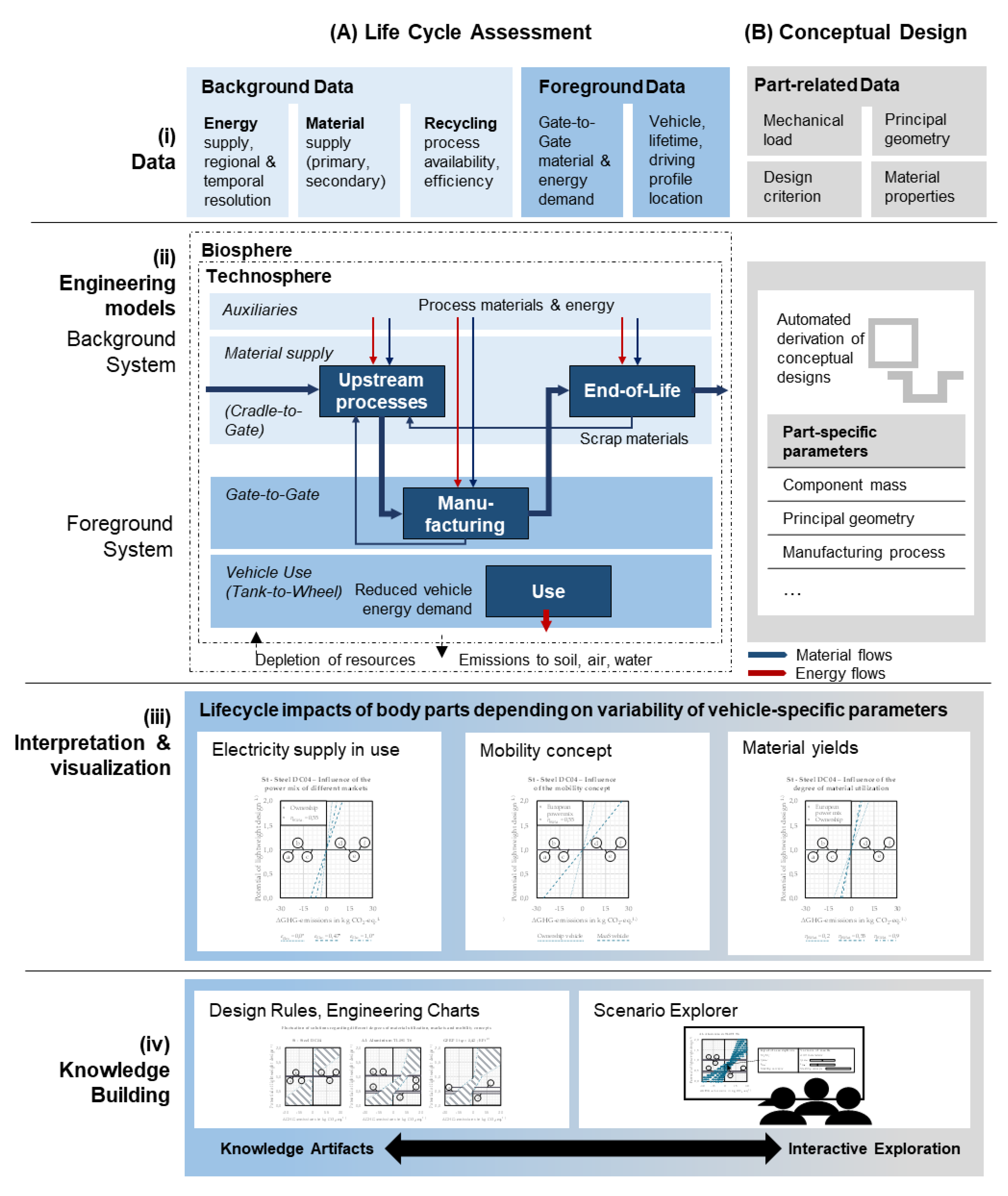

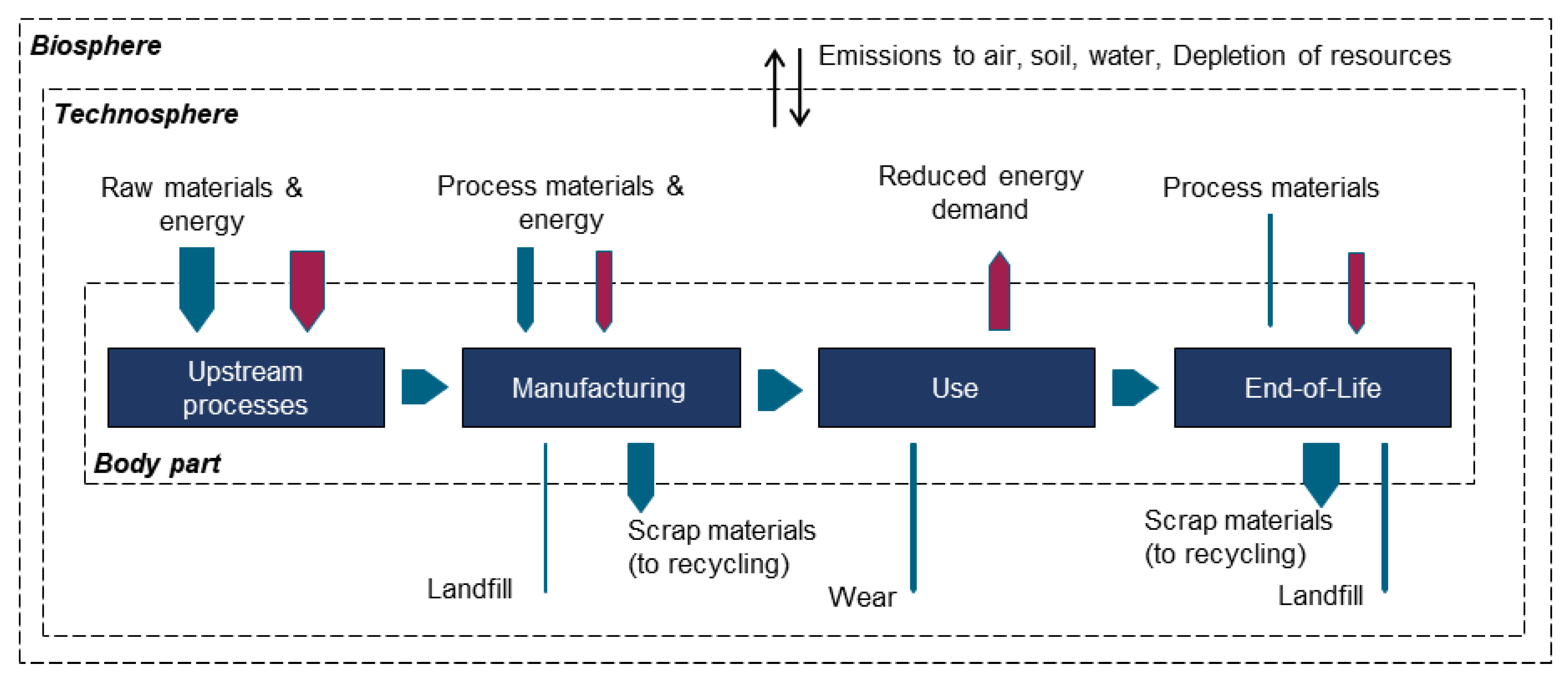

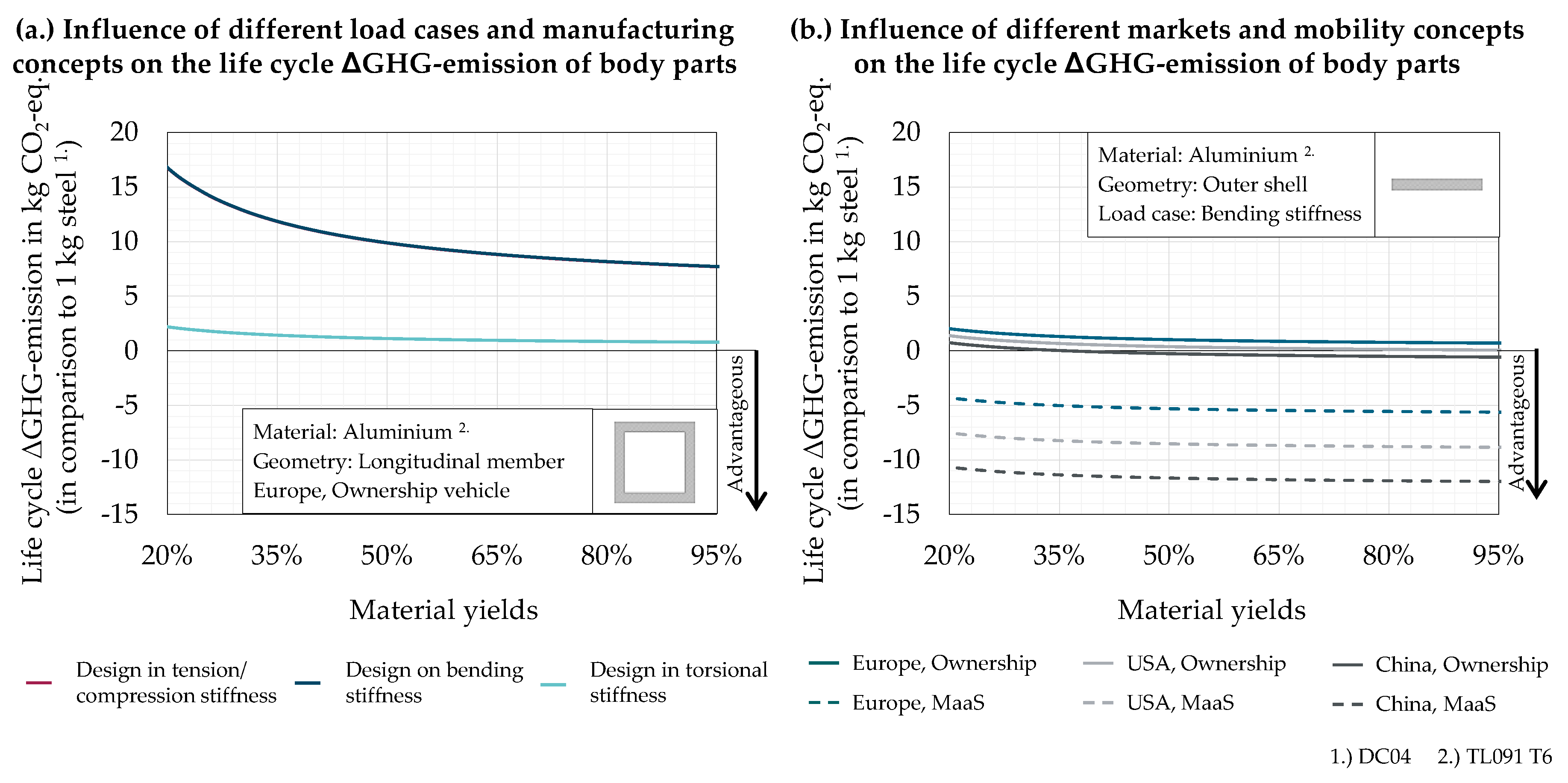

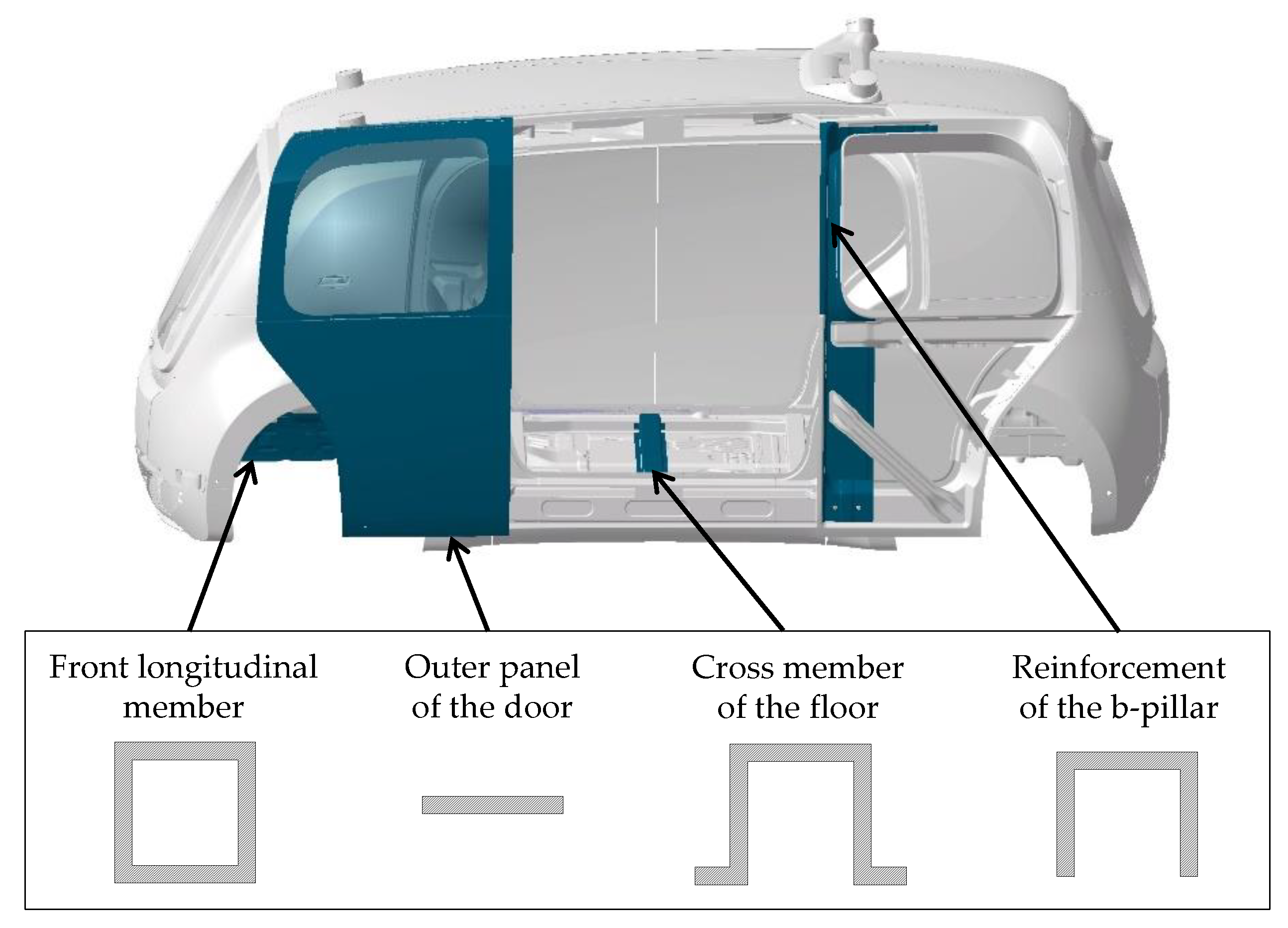

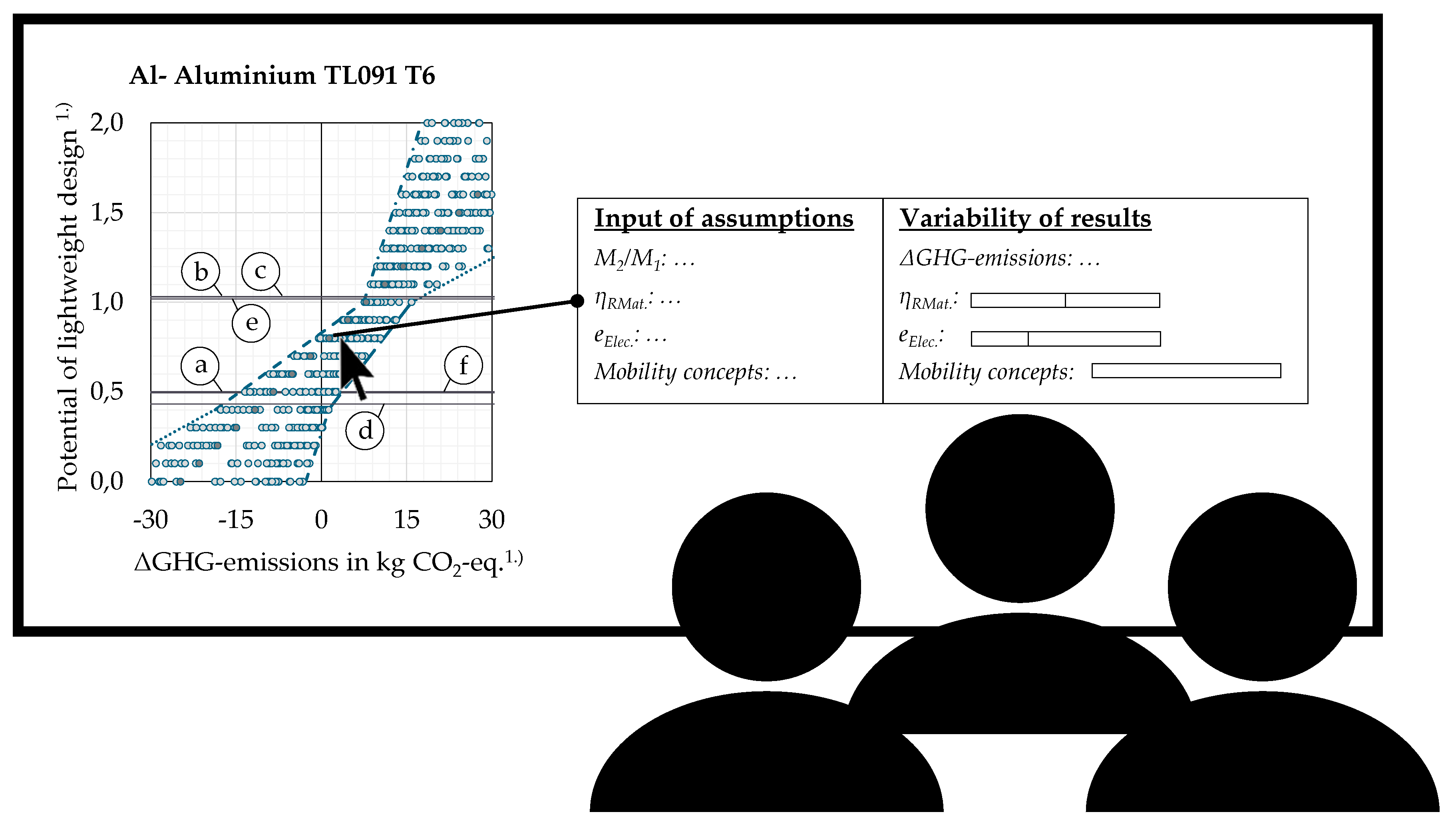
| Ermolaeva et al. 2004 [21] | Grujicic et al. 2009 [22] | Poulikidou et al. 2015 [23] | Mayyas et al. 2012, 2016 [24,25] | Kaspar et al. 2017, Kaspar et al. 2018, Stoffels et al. 2017 [26,27,28] | Egede 2017 [6] | Delogu 2018 [29,30] Dattilo 2017 [31] | Luk et al. 2017, Luk et al. 2018 [32,33] | |
|---|---|---|---|---|---|---|---|---|
| Task 1: Conceptual Design 4 Issues addressed; 0 Issue not in focus of approach/unclear | ||||||||
| Consideration of different materials | 4 | 4 | 4 | 4 | 4 | 4 | 0 | 4 |
| Based on simplified product models | 0 | 0 | 4 | 4 | 4 | 0 | 0 | 0 |
| Consideration of installation space | 0 | 0 | 0 | 0 | 4 | 0 | 0 | 0 |
| Task 2: Life Cycle Assessment Taking into Account Variability 4 Issues addressed; 2 Issues partly discussed, e.g., sensitivity; 0 Issue not in focus of approach/unclear | ||||||||
| Considered Life Cycle Stages | ||||||||
| Upstream Processes | 4 | 0 | 4 | 4 | 4 | 4 | 4 | 4 |
| Manufacturing (Gate-to-Gate) | 4 | 4 | 4 | 4 | 4 | 0 | 4 | 4 |
| Use Stage (Combustion/Electric) | 4/0 | 0 | 4/0 | 4/0 | 4/0 | 4/4 | 4/0 | 4/4 |
| End-of-Life | 4 | 4 | 4 | 4 | 4 | 0 | 4 | 4 |
| Consideration of technological variability | 2 | 0 | 4 | 2 | 0 | 0 | 2 | 0 |
| Consideration of spatial variability | 0 | 0 | 2 | 0 | 0 | 4 | 0 | 0 |
| Task 3: Interpretation and Prioritization of Concept Alternatives 4 Issues addressed; 0 Issue not in focus of approach/unclear | ||||||||
| Quantitative Interpretation of Results | 4 | 4 | 4 | 4 | 4 | 4 | 4 | 4 |
| Decision-support for Conceptual Design | 0 | 0 | 0 | 0 | 4 | 0 | 0 | 0 |
| Task | Findings |
|---|---|
| Task 1: Conceptual Design |
|
| Task 2: Life Cycle Assessment Taking into Account Variability |
|
| Task 3: Concurrent Interpretation and Prioritization of Concept Alternatives |
|
| Part-Specific Influence Factors on the Life Cycle ΔGHG-Emissions of Body Parts | ||||
|---|---|---|---|---|
| Design Parameter | Options | |||
| Body part geometry |  |  |  |  |
| Load case | Tension/Compression | Bending | Torsion | Buckling |
| Design criterion | Stiffness | Strength | ||
| Life Cycle Stage | System Description |
|---|---|
| Upstream Processes |
|
| Manufacturing |
|
| Use |
|
| End-of-Life |
|
| No. | Life Cycle Stage | Equation | |
|---|---|---|---|
| 1 | Upstream processes | (15) | |
| 2 | Manufacturing | (16) | |
| 3 | Use | (17) | |
| 4 | End-of-Life | (18) |
| Vehicle-Specific Influence Factors on the Life Cycle ΔGHG-Emissions of Body Parts | ||
|---|---|---|
| Design Parameter | Options | |
| Manufacturing concept | Shell construction | Profile construction |
| Mobility concept | Ownership | Mobility-as-a-Service |
| Use stage electricity mix of different markets * [kg CO2-eq./kWh] |  | |
| Material | Potential of Lightweight Design | |||||||||||
|---|---|---|---|---|---|---|---|---|---|---|---|---|
| a. | b. | c. | d. | e. | f. | |||||||
 | Bending Stiffness |  | Tension/Com-Pression Stiffness |  | Bending Stiffness |  | Torsional Stiffness |  | Bending Stiffness |  | Torsional Stiffness | |
| St | 1,000 | 1,000 | 1,000 | 1,000 | 1,000 | 1,000 | ||||||
| Al | 0,496 | 1,032 | 1,031 | 0,432 | 1,019 | 0,503 | ||||||
| GFRP 1 | 0,489 | 2,499 | 2,467 | 0,409 | 2,301 | 0,627 | ||||||
| GFRP 2 | - | 1,467 | 1,875 | - | 1,795 | - | ||||||
| GFRP 3 | - | - | - | 0,355 | - | 0,473 | ||||||
| CFRP 1 | 0,305 | 0,832 | 0,831 | 0,351 | 0,812 | 0,541 | ||||||
| CFRP 2 | - | 0,414 | 0,596 | - | 0,588 | - | ||||||
| CFRP 3 | - | - | - | 0,241 | - | 0,281 | ||||||
| Limit | 0 < M2/M1 ≤ p | p < M2/M1 ≤ 1 | 1 < M2/M1 ≤ 2 |
|---|---|---|---|
| Best case (left limit) | ηRMat. ↓; eElec. ↑; MaaS (eERV ↑; sLC ↑) | ηRMat. ↑; eElec. ↑; MaaS (eERV ↑; sLC↑) | ηRMat. ↑; eElec. ↓; Ownership (eERV ↓; sLC ↓) |
| Worst case (right limit) | ηRMat. ↑; eElec. ↓; Ownership (eERV ↓; sLC ↓) | ηRMat.↓; eElec. ↓; Ownership (eERV ↓; sLC↓) | ηRMat. ↓; eElec. ↑; MaaS (eERV ↑; sLC ↑) |
© 2020 by the authors. Licensee MDPI, Basel, Switzerland. This article is an open access article distributed under the terms and conditions of the Creative Commons Attribution (CC BY) license (http://creativecommons.org/licenses/by/4.0/).
Share and Cite
Reimer, L.; Kaluza, A.; Cerdas, F.; Meschke, J.; Vietor, T.; Herrmann, C. Design of Eco-Efficient Body Parts for Electric Vehicles Considering Life Cycle Environmental Information. Sustainability 2020, 12, 5838. https://doi.org/10.3390/su12145838
Reimer L, Kaluza A, Cerdas F, Meschke J, Vietor T, Herrmann C. Design of Eco-Efficient Body Parts for Electric Vehicles Considering Life Cycle Environmental Information. Sustainability. 2020; 12(14):5838. https://doi.org/10.3390/su12145838
Chicago/Turabian StyleReimer, Lars, Alexander Kaluza, Felipe Cerdas, Jens Meschke, Thomas Vietor, and Christoph Herrmann. 2020. "Design of Eco-Efficient Body Parts for Electric Vehicles Considering Life Cycle Environmental Information" Sustainability 12, no. 14: 5838. https://doi.org/10.3390/su12145838
APA StyleReimer, L., Kaluza, A., Cerdas, F., Meschke, J., Vietor, T., & Herrmann, C. (2020). Design of Eco-Efficient Body Parts for Electric Vehicles Considering Life Cycle Environmental Information. Sustainability, 12(14), 5838. https://doi.org/10.3390/su12145838





